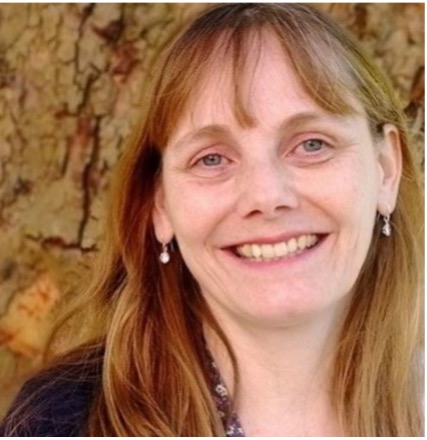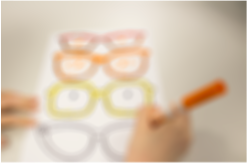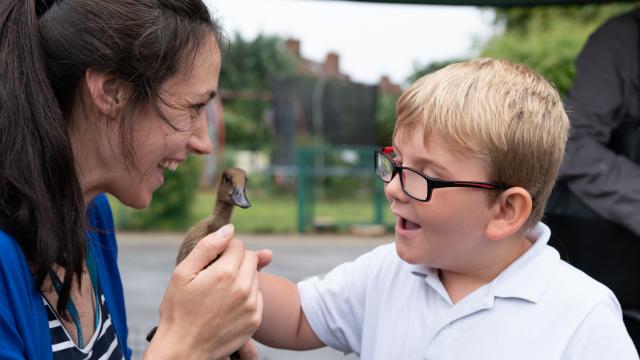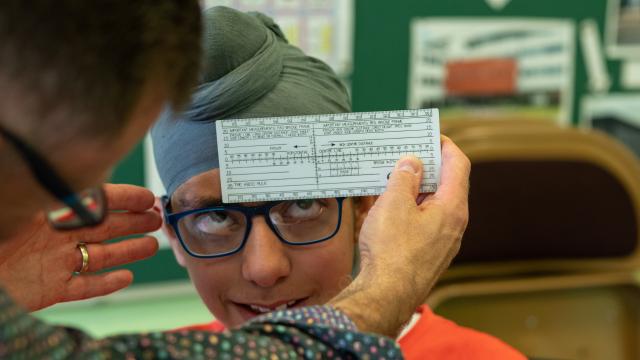Why early eye care in special schools addresses preventable sight loss
The government backs the Special Schools Eye Care Service!
In June 2023 we were delighted to receive confirmation from the government that NHS sight tests will be on offer to all pupils in special schools from 2024/2025. As the article below was written when the service was in jeopardy, it may now contain some out of date information relating to future provision. Thank you to everyone who has supported the campaign, written blogs and stood firm about the benefits of the service.
This week we are featuring a series of blogs on the benefits of the NHS Special Schools Eye Care Service. Here Louise Gow, who is delivering the Service as part of a SeeAbility eye care team, and who is also Clinical lead for eye health and low vision at RNIB, explains why working with younger children in special schools offers a crucial window of opportunity to prevent sight loss.
Louise shares a story of a child whose sight could have been saved had the Service existed before.
 “Every day 250 people start to lose their sight and 50% of that could be prevented. Much of this is due to lack of the correct spectacles and barriers to accessing eye care. What many people don’t realise is there is a huge window of opportunity to prevent sight loss in younger children while eyesight is still developing to 8 years of age, or thereabouts.
“Every day 250 people start to lose their sight and 50% of that could be prevented. Much of this is due to lack of the correct spectacles and barriers to accessing eye care. What many people don’t realise is there is a huge window of opportunity to prevent sight loss in younger children while eyesight is still developing to 8 years of age, or thereabouts.
In basic terms, the eyes and the brain are still learning to work together. Anything that is causing a problem in one or both eyes can leave a child’s brain starting to ignore it leading to reduced vision. Colloquially you may have heard of the term ‘lazy eye’ - clinically we call it ‘amblyopia.’
But whatever you call it, catch the problem early and treat it – most commonly with glasses and sometimes patching and then eyesight can recover. Discover too late though and a child can suffer permanently reduced vision.
Children who have learning disabilities are 28 times more likely to have a problem with their vision and face multiple communication and physical barriers to accessing eye care. These are children whose sight problems are much more likely to be masked, and they may not complain of any symptoms.
In my work with RNIB providing specialist eye tests for adults with learning disabilities I regularly come across people whose sight loss could have been prevented. So last year I started working for SeeAbility in a special school for autistic children, under the contract to deliver the NHS Special Schools Eye Care Service. The majority of children I see have never had an eye test, despite many parents listing significant family history of eye conditions.
Many children with learning disabilities find clinical settings frightening and overwhelming. If a child appears to see well then an eye test is an unnecessary trigger of distress and one less battle to fight. I can understand why a parent would not want to put their child through this.
In school we are able to provide an eye test in a calm, familiar, non-clinical and secure environment. We are able to test the eyes of children who are not able to communicate or interact in the test using specialist equipment and techniques.
It is honestly so rewarding, one of the first tests I did was for a child who had never had glasses – when she got them I got the biggest hug! She has now learnt to spell her name.
One child, Jonathan, stands out for the wrong reasons however. He has a strong family history of squint (where the eye turns) and lazy eye. His eyes look straight and on the face of it, he is able to see small details close and far with both eyes open. No-one would suspect anything is wrong.
 Jonathan had his first sight test with me at age 13. I found he can only see perfectly in his left eye. In his right eye he is severely long sighted. The picture illustrates what Jonathan can ‘really’ see up close out of that eye.
Jonathan had his first sight test with me at age 13. I found he can only see perfectly in his left eye. In his right eye he is severely long sighted. The picture illustrates what Jonathan can ‘really’ see up close out of that eye.
He is living with impaired vision and with it an increased lifetime risk of sight loss, that could have been prevented. If the NHS Special Schools Eye Care Service had existed when he was much younger, we could have treated Jonathan’s vision. Of course he now has the glasses he needs to help compensate but that is not the same.
It alarms me that if the NHS now shrink the Service to one for only residential special schools, which support mainly older children in their teens, we will miss this ‘window of opportunity’ of seeing many children at a younger age in their day special school.
Every child matters, every child deserves access to eye care and if that child has learning disabilities adaptation to enable that to happen is essential. This Service is not a luxury it is a reasonable and evidenced way of providing the care that children like Jonathan deserve.”
For more information about eye care for people with learning disabilities, including support for children, please see SeeAbility’s resources.



